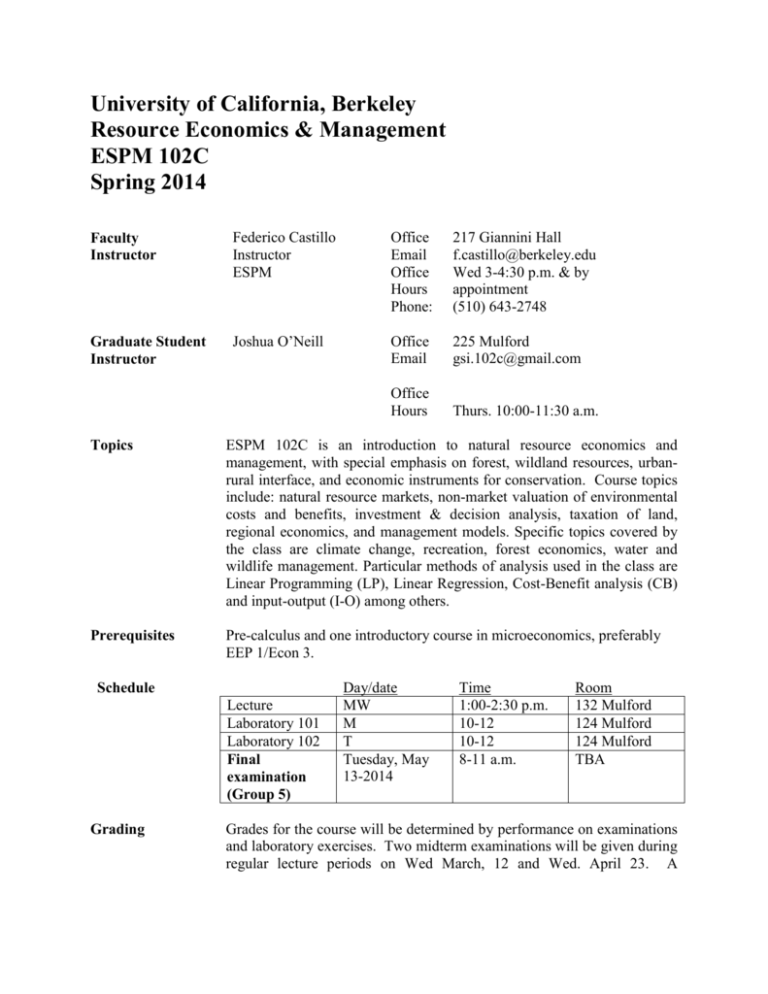
University of California, Berkeley
Resource Economics & Management
ESPM 102C
Spring 2014
Faculty
Instructor
Federico Castillo
Instructor
ESPM
Office
Email
Office
Hours
Phone:
217 Giannini Hall
f.castillo@berkeley.edu
Wed 3-4:30 p.m. & by
appointment
(510) 643-2748
Graduate Student
Instructor
Joshua O’Neill
Office
Email
225 Mulford
gsi.102c@gmail.com
Office
Hours
Thurs. 10:00-11:30 a.m.
Topics
ESPM 102C is an introduction to natural resource economics and
management, with special emphasis on forest, wildland resources, urbanrural interface, and economic instruments for conservation. Course topics
include: natural resource markets, non-market valuation of environmental
costs and benefits, investment & decision analysis, taxation of land,
regional economics, and management models. Specific topics covered by
the class are climate change, recreation, forest economics, water and
wildlife management. Particular methods of analysis used in the class are
Linear Programming (LP), Linear Regression, Cost-Benefit analysis (CB)
and input-output (I-O) among others.
Prerequisites
Pre-calculus and one introductory course in microeconomics, preferably
EEP 1/Econ 3.
Schedule
Lecture
Laboratory 101
Laboratory 102
Final
examination
(Group 5)
Grading
Day/date
MW
M
T
Tuesday, May
13-2014
Time
1:00-2:30 p.m.
10-12
10-12
8-11 a.m.
Room
132 Mulford
124 Mulford
124 Mulford
TBA
Grades for the course will be determined by performance on examinations
and laboratory exercises. Two midterm examinations will be given during
regular lecture periods on Wed March, 12 and Wed. April 23. A
ESPM 102C: Resource Economics & Management
Course Outline
Spring 2013
comprehensive final examination will be given on Tuesday May 13, from
8:00 to 11:00 A.M.
Laboratory exercises must be submitted to the GSI at the beginning of the
next laboratory session.
Please note: Two essays need to be written during the semester. Each
essay cannot be longer than two pages and should deal with a topic related
to the class and related to a reading, a newspaper article or any other
contemporary topic related to the class. Each of those essays counts as a
lab assignment. You can turn in the essays at any point in time following
this schedule:
First essay: On or before 3/24/14
Second essay: On or before 4/23/2014
No credit will be given for late work. Course grades will be determined
as follows:
Midterms, 50%;
Final 20%
Lab work 30%.
Topics and Readings
A reader is required for the class. The readings below are included in the reader and will
be covered during the duration of the semester. Students are expected to have completed
the readings for a topic before the lecture on that topic. The reader is available at:
Copy Central in downtown Berkeley
48 Shattuck Square, Berkeley CA 94704.
Ph.: (510)8487034
Additional readings may be distributed and they become part of the course.
Microeconomics review:
Leeds, Michael A.; von Allmen, Peter, and Schiming, Richard C. “Market Failure: Public Goods
and Externalities” in “Economics”. Pearson Addison Wesley, pp. 435-453. 2006.
Perloff, Jeffrey M. “Consumer Choice” in “Microeconomics”. Pearson, Addison Wesley, pp.
74-102. 2007.
Investment Analysis
2
ESPM 102C: Resource Economics & Management
Course Outline
Spring 2013
Buongiorno, J. and J.K. Gilless. 2003. Decision methods for forest resource management.
Academic Press, San Diego. 439 p. (Read Chapter 18, “Analysis of forest resource
investments”)
Bettinger, Pete; Boston, Kevin; Siry, Jacek P.; Grebner, Donald L. “Management of Forests and
Other Natural Resources” in “Forest Management and Planning”. Elsevier, pp. 2-13.
2009
Klemperer, W.D. 1996. Forest resource economics and finance. McGraw-Hill, New York. 551
pages. (Chapter 4, “The forest as capital”, pages 101-133)
Forestry Investments
Klemperer, W.D. 1996. Forest resource economics and finance. McGraw-Hill, New York. 551
pages. (Read Chapter 7, “Economics of forestland use and even-aged rotations”, pages
202-238)
Klemperer, W.D. 1996. Forest resource economics and finance. McGraw-Hill, New York. 551
pages. (Read Chapter 8, “Optimal timber stocking”, pages 239-265)
Taxation
Klemperer, W.D. 1996. Forest resource economics and finance. McGraw-Hill, New York. 551
pages. (Read Chapter 9, “Forest taxation”, pages 266-301)
Valuation
Davis, L.S. et al. 2001. Forest Management. McGraw-Hill, New York. 804 pages. (Read Chapter
8, “Principles and applications in forest valuation”, pages 395-462)
Markets-Forecasting: Timber Markets
Klemperer, W.D. 1996. Forest resource economics and finance. McGraw-Hill, New York. 551
pages. (Read Chapter 12, “Timber supply and demand”, pages 362-394)
Econometric Models
Buongiorno, J. and J.K. Gilless. 2003. Decision methods for forest resource management.
Academic Press, San Diego. 439 p. (Read Chapter 19, “Econometric analysis and
forecasting of forest product markets”)
Regional Economics
Loomis, J.B. 2002. Integrated Public Lands Management. Columbia, New York. 474 pages.
(Read Chapter 7, “Regional economic analysis and input-output models”, pages 171-191)
3
ESPM 102C: Resource Economics & Management
Course Outline
Spring 2013
Bureau of Business and Economic Research. “The Regional Economy”.
Forest management models
Buongiorno, J. and J.K. Gilless. 2003. Decision methods for forest resource management.
Academic Press, San Diego. 439 p. (Read Chapter 1, “Introduction”, Chapter 2,
“Principles of linear programming: Formulations”, Chapter 3, “Principles of linear
programming: Solutions”, Chapter 4 “Even-aged management: A first model”)
Biodiversity/Protected Areas
United Nations Environmental Programme. “Global Biodiversity Assessment”. Chapter 12.
2001.
Recreation
Douglas, R.W. 1993. Forest Recreation. Waveland, Prospect Heights. 373 pages. (Read Chapter
5, “Financing forest recreation”, pages 99-114)
Emerton, Lucy; Bishop, Joshua and Thomas, Lee. "Sustainable Financing of Protected Areas:
Global Review of Challenges and Options." 2006, pp. 97. Read Chapter 7.
Multiple Use
Loomis, J.B. 2002. Integrated Public Lands Management. Columbia, New York. 474 pages.
(Read Chapter 8, “Principles and applications of multiple-use management”, pages 192220)
Water
Young, Robert. “The Economic Value of Water: Concepts and Methods”. Resources for the
Future. Washington D.C. 357 pages. (Read Chapters 1 and 2).
Economic Valuation
Stevens, Thomas. “Can Stated Preference Valuations Help Improve Environmental Decision
Making?” Choices. 2005. pp. 189-193
Shaw, Douglas W. “The road less traveled: Revealed Preferences and using the Travel Cost
Method to value environmental changes” Choices. 3rd Quarter. 2005.
Hanley, Nick; Shogren, Jason F. and White, Ben. “Valuing the environment and Natural
Resources” in “Introduction to Environmental Economics”. Oxford University Press, pp. 34-67.
2001.
4






